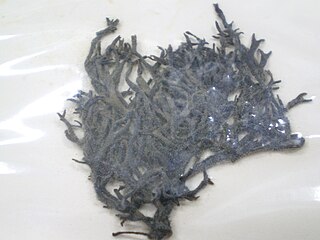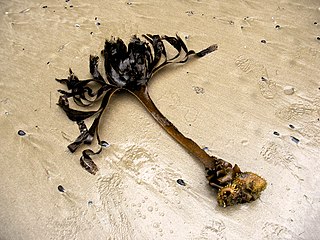
The brown algae, comprising the class Phaeophyceae, are a large group of multicellular algae, including many seaweeds located in colder waters within the Northern Hemisphere. Most brown algae live in marine environments, where they play an important role both as food and as a potential habitat. For instance, Macrocystis, a kelp of the order Laminariales, may reach 60 m (200 ft) in length and forms prominent underwater kelp forests. Kelp forests like these contain a high level of biodiversity. Another example is Sargassum, which creates unique floating mats of seaweed in the tropical waters of the Sargasso Sea that serve as the habitats for many species. Many brown algae, such as members of the order Fucales, commonly grow along rocky seashores. Some members of the class, such as kelps, are used by humans as food.

Sporochnacaeae is the only family in the order Sporochnales in the brown algae. Member of this family are thread-like algae growing by means of an intercalary row of dome shaped cells at the base of the hairs.

Ectocarpales is a very large order in the brown algae. The order includes families with pseudoparenchymatous (Splachnidiaceae) or true parenchymatous (Scytosiphonaceae) tissue. Pseudoparenchymatous refers to a filamentous alga with cells packed very close together to give an appearance of parenchymatous tissue, the latter being composed of cells which can truly divide in three dimensions, unusual among the algae. Filamentous algae are composed of cells that divide along a single plane, allowing only elongation to form filaments of one or more rows of cells. Algae that can divide in two planes can form sheet-like thalli or bodies. Cells that can divide in a third plane potentially allow for the organism to develop a more complex body plan, and diversification of body plans into an erect thallus of some sort and a holdfast for attaching the upright portion to the substrate.

Sargassaceae is a family of brown algae in the order Fucales.
Syringodermataceae is a family of brown algae. It includes two genera, Microzonia and Syringoderma.

Cutleriaceae is a family of brown algae. It includes two genera, Cutleria and Zanardinia.

Ishigeales is an order of brown algae. It includes two families, Ishigeaceae and Petrodermataceae. The genus Diplura is also included, but not placed to family.

Tilopteridales is an order of brown algae with isomorphic alternation of generations.

Scytothamnales is an order of brown algae.
Discosporangiales is an order of brown algae. It includes two families, Choristocarpaceae and Discosporangiaceae.

Ralfsiales is an order of crustose brown algae containing two families.

Dictyotaceae is large family of brown algae. Members of this order generally prefer warmer waters than other brown algae. One genus in this order is calcareous, Padina, the only calcareous member of this class. Lobophora variegata often presents a beautiful blue iridescence due to microscopic bacteria which live on the surface of the blades [interesting observation but needs citation - please substantiate, clearly there are bacteria on the blades but are they the source of the iridescence?]. A number of genera are known as forkweed (e.g. Dictyota, Glosophora, Dilophus, Dictyopteris, Pachydictyon and Lobospira.

Himanthalia is a genus of brown algae. It is the only genus in the family Himanthaliaceae in the order Fucales. It includes two species: Himanthalia durvillei and Himanthalia elongata.

Splachnidiaceae is a family of brown algae in the order Scytothamnales.

Scytothamnus is a brown algae genus in the family Splachnidiaceae.

Phyllariaceae is a family of brown algae in the order Tilopteridales.

Scytosiphonaceae is a family of brown algae in the order Ectocarpales.

Ectocarpaceae is a family of brown algae in the order Ectocarpales. It includes four genera, Ectocarpus, Kuckuckia, Pleurocladia, and Spongostema.

Acinetosporaceae is a family of brown algae in the order Ectocarpales.

Sporochnus elsieae is a marine brown algal species in the family Sporochnaceae, endemic to New Zealand. It was first described in 1960 by Victor Lindauer who gave it the specific epithet, elsieae, in honour of his wife, Elsie.

















